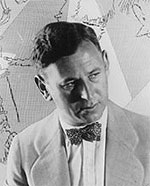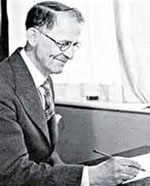A Rube Goldberg by Any Other Name…
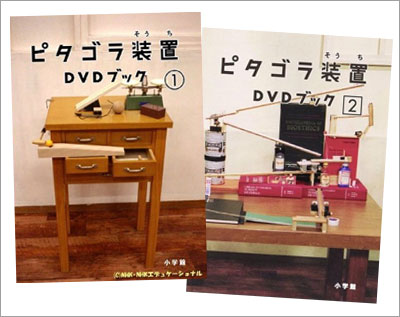
In this article New York based artists Nick Kent gives us a riveting world tour of all things Rube Goldberg:
I was browsing Japanese DVDs at a bookstore the other day when between the anime and live concert discs I spotted strange wooden contraptions on the covers of a pair of DVDs.
It turns out to be a compilation of short segments that link the main segments on NHK’s (sort of like the Japanese PBS’ or BBC’s) kids science program Pythagoras Switch (Pitagora Suicchi).
A Pythagoras Switch describes an invention that relies on a complicated and debatably over complex physics chain reaction to achieve a simple final goal. Pythagoras was the 5th Century B.C. Greek mathematician and philosopher.
While the name of the program is more or less in English neither the U.S. or U.K. normally use the term Pythogoras Switch though other countries seem to. In the U.S. inventions like the ones seen are commonly called Rube Goldberg devices (or inventions, machines or contraptions) after Reuben “Rube” Goldberg (1883-1970) an American cartoonist and general eccentric:
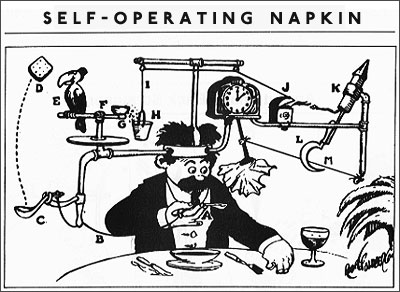
Although he drew lengthier newspaper comic strips he was by far most famous for his one panel Rube Goldberg Inventions cartoon illustrations published in the mid 20th Century. Interestingly the internet does not quickly reveal how long they ran or the best known papers who ran them. His career began in 1915.
In 1963 the Ideal Toy company created a popular and long lived board game with plastic and metal parts called Mouse Trap, Here is a review with what looks like 80s artwork on the board
While blatantly based on his illustrations Rube Goldberg himself found he could not file a successful lawsuit since Ideal and the company who designed it for them were basing the game on the general concept and idea of his strips and not specifically anything he held the rights to. The game, which adults commonly identified as connected somehow to him as well as a new status as a predecessor to pop art in the 60s did bring him new recognition though I’m not sure he was able to successfully capitalize on it much. I remember as a kid my dad had a book about pop art and by far my favorite image in it was a a blow-up of one of his comics.
With the success of Mouse Trap, Ideal created a sequel in 1964, Crazy Clock:
I remember as a kid an older sibling of a friend had this game I remembered in my head this “out of bed” game all these years but never saw it again or knew the actual name until youtube. Only Mouse Trap was still being sold when I was little. It turns out they tried again the next year with Fish Bait:
This one doesn’t really look much like a Rube Goldberg illustration and apparently wasn’t successful enough to create another game sequel.
In 1987, Swiss artists Peter Fischli and David Weiss made a 30 minute video inspired by Rube Goldberg:
Definitely adding a new dimension for it’s much longer format it appears like a single non-stop take but when examined closely you can see it’s made up of shorter cuts which were camouflaged through editing to look continuous. Like Mouse Trap, since the film seems inspired by rather than directly using the work of or crediting Rube Goldberg. The somewhat viral nature of the video in turn definitely inspired some later commercial work based on The Way Things Go without crediting the video makers or a now passing into obscurity Rube Goldberg. Fortunately his legacy has been kept aimed by an invention contest named after him.
In England Rube Goldberg’s illustrations never became a commonly used term because they had an independently popular local contemporary to him, W. Heath Robinson (1872-1944). He was initially a book illustrator from a family of book illustrators but became best known for spot illustrations for magazines of eccentric and convoluted inventions: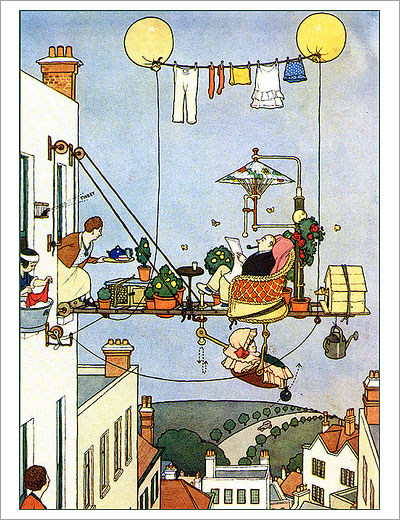
Unlike Rube Goldberg, Robinson’s Inventions did not typically rely on chain reactions. During WWII the British ran a secret facility at Bletchley Park to decode German coded messages. They developed what are considered some of the first computers there and called one of their earlier top secret machines “Heath Robinson”. Another of Heath Robinson’s seeming inspirations for illustrations was modern design. I spotted this one:
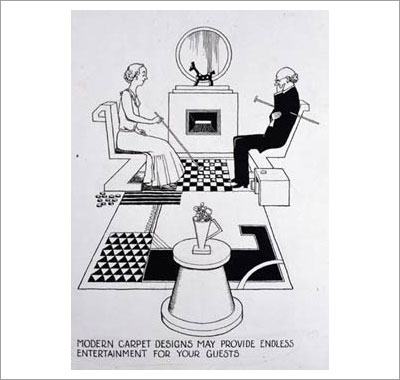
Which I found ironically amusing because when I was a kid people would actually buy carpet like this for their basement playrooms. I’m sure kids would gather down there to play or rather watch Mouse Trap in action.
Nick Kent is a New York based artist who works with electronic media and is an occasional pop culture pundit.















